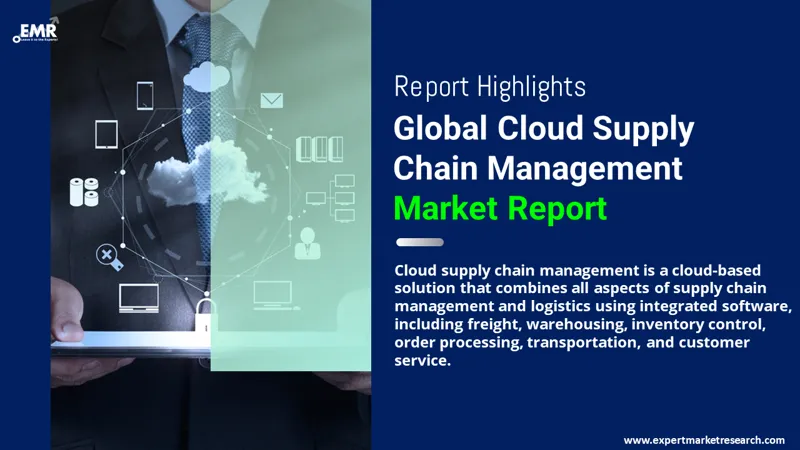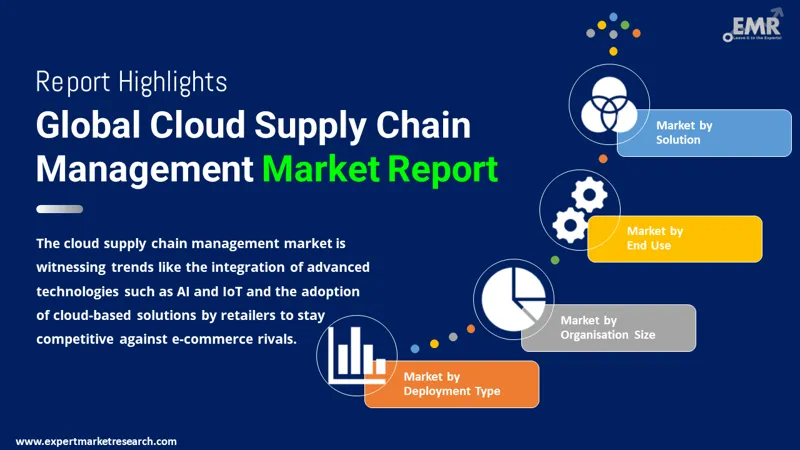
Consumer Insights
Uncover trends and behaviors shaping consumer choices today
Procurement Insights
Optimize your sourcing strategy with key market data
Industry Stats
Stay ahead with the latest trends and market analysis.
The global cloud supply chain management market reached a value of approximately USD 7.88 Billion in 2025. The market is projected to grow at a CAGR of 11.10% between 2026 and 2035, reaching a value of around USD 22.58 Billion by 2035.
Base Year
Historical Period
Forecast Period
Germany automotive industry generated a total revenue volume of EUR410.9 billion in 2021 increased by 8% from 2020.
As per the National Retail Foundation, the United States has annual retail sales growth of $5.1 trillion in 2023.
The manufacturing sector's net turnover in the EU business economy reached 8.3 trillion, up 16% from 2020.
Compound Annual Growth Rate
11.1%
Value in USD Billion
2026-2035
*this image is indicative*
Cloud supply chain management integrates all aspects of supply chain management and logistics, including freight, warehousing, inventory control, order processing, transportation, and customer service, within a unified software platform.
It enables the automation and management of maintenance, administration, and capacity planning processes on the cloud, ensuring operational efficiency is maintained. Cloud supply chain management can enhance business profitability by tracking operations, automating inventory management, and optimising routes.
According to the data from the Australian Bureau of Statistics (ABS), the number of Financial and Insurance Services businesses in Australia has increased by 2.8% in 2022-2023 while there were 2,589,873 actively trading businesses by 30 June 2023, indicating the increasing operations, and processes creating a demand for the cloud supply chain management solutions.

Read more about this report - REQUEST FREE SAMPLE COPY IN PDF
Increasing automation, increasing penetration of technologies, rising adoption of cloud-based solutions, and rising demand for real-time visibility and analytics are the major trends impacting global cloud supply chain management market growth.
The growing adoption of automation in supply chain management allows businesses to monitor critical processes efficiently. Cloud-based solutions streamline operations, optimize workflows, and improve supply chain visibility.
As technologies like AI, IoT, and blockchain become more prevalent, smart supply chains are poised to replace traditional methods, fueling the expansion of the cloud supply chain management market.
The surge in cloud-based solutions adoption propels market growth by offering scalability, real-time data access, cost-effectiveness, and rapid deployment for enhanced efficiency and competitiveness.
Rising demand for real-time visibility and analytics empowers businesses to continuously monitor and analyse supply chain processes, enabling agile decision-making and operational optimisation.
The supply chain management landscape is evolving rapidly, driven by increasing automation and the adoption of advanced technologies like AI, IoT, and blockchain. Cloud-based solutions are pivotal, offering scalability, real-time data access, and cost-effectiveness.
Businesses prioritise real-time visibility and analytics to optimise operations and make agile decisions. These trends collectively enhance efficiency, competitiveness, and responsiveness across the supply chain management market. Supply chain management advances with increasing automation, technology adoption (AI, IoT, blockchain), cloud solutions, and demand for real-time visibility and analytics, driving innovation, efficiency, and competitiveness.

Read more about this report - REQUEST FREE SAMPLE COPY IN PDF
“Cloud Supply Chain Management Market Report and Forecast 2026-2035” offers a detailed analysis of the market based on the following segments:
Market Breakup by Solution
Market Breakup by Deployment Type
Market Breakup by Organisation Size
Market Breakup by End Use
Market Breakup by Region
Inventory and Warehouse Management is often the dominant solution driving the global cloud supply chain management market.
The adoption of cloud-based inventory and warehouse management solutions provides businesses with enhanced visibility, scalability, and real-time data access, which are crucial for effective supply chain management. This leads to increased accuracy, reduced operational costs, and improved overall efficiency, making it a primary focus in cloud supply chain management. This segment generally leads because of its essential role in optimizing storage, monitoring inventory levels, and ensuring efficient warehouse operations.
The retail segment commands a substantial share of the market based on end use. The sector's increasing adoption of cloud-based technology to compete with e-commerce rivals is fueling this segment's growth.
Cloud supply chain management is becoming more popular due to its scalability, visibility, and valuable data insights, providing a deeper understanding of customer buying journeys. Furthermore, digitizing inventory management with cloud solutions significantly reduces operational costs, contributing to overall market expansion.
The companies develop enterprise software catering to the operational and planning demands of various organisations, prominent computer technology corporation which provides hybrid cloud, catering to the software demands of aerospace and defence, among other sectors, and known for its hardware and software offerings, including computers, servers, storage systems.
SAP SE: Founded in 1972, with its headquarters in Germany, SAP SE is a leading multinational software company, that develops enterprise software catering to the operational and planning demands of various organisations.
Oracle Corporation: Founded in 1977, with its headquarters in the United States, Oracle Corporation is a prominent computer technology corporation which provides hybrid cloud, integration, and networking, among other solutions.
Infor: Founded in 2002, with its headquarters in the United States, Infor is a renowned enterprise software company providing industry-specific solutions, catering to the software demands of aerospace and defence, among other sectors.
IBM Corporation: Founded in 1911, with its headquarters in the United States, IBM is renowned for its hardware and software offerings, including computers, servers, storage systems, and networking equipment.
*Please note that this is only a partial list; the complete list of key players is available in the full report. Additionally, the list of key players can be customized to better suit your needs.*
Other global cloud supply chain management market key players are Blue Yonder, Inc., Accenture Plc, Logility Inc., Korber AG, Cloud Logix LLC, and Tecsys Inc. among others.
North America holds a significant portion of the cloud supply chain management market. The demand for better supply chain management, driven by long wait times and blockages, is expected to boost technology adoption and the popularity of cloud solutions in the forecast period.
Increasing collaborations between end users and technology providers to enhance visibility and safety in supply chain processes are further expanding market opportunities in this region.




*While we strive to always give you current and accurate information, the numbers depicted on the website are indicative and may differ from the actual numbers in the main report. At Expert Market Research, we aim to bring you the latest insights and trends in the market. Using our analyses and forecasts, stakeholders can understand the market dynamics, navigate challenges, and capitalize on opportunities to make data-driven strategic decisions.*
Get in touch with us for a customized solution tailored to your unique requirements and save upto 35%!
The market was valued at USD 7.88 Billion in 2025.
The market is projected to grow at a CAGR of 11.10% between 2026 and 2035.
The revenue generated from the cloud supply chain management market is expected to reach USD 22.58 Billion in 2035.
The market is categorised according to the solution, including demand planning and forecasting, inventory and warehouse management, product life-cycle management, transportation and logistics management, sales and operations planning, and others.
The market is categorised according to the organisation type, which includes large enterprises and small and medium enterprises.
The market key players are SAP SE, Oracle Corporation, Infor, IBM Corporation, Blue Yonder, Inc., Accenture Plc, Logility Inc., Korber AG, Cloud Logix LLC, and Tecsys Inc. among others.
Based on the deployment type, the market is divided into hybrid cloud, public cloud, and private cloud.
Based on the end use, the market is divided into automotive, food and beverage, healthcare, manufacturing, oil and gas, retail, and others.
The market is broken down into North America, Europe, Asia Pacific, Latin America, and Middle East and Africa.
Explore our key highlights of the report and gain a concise overview of key findings, trends, and actionable insights that will empower your strategic decisions.
| REPORT FEATURES | DETAILS |
| Base Year | 2025 |
| Historical Period | 2019-2025 |
| Forecast Period | 2026-2035 |
| Scope of the Report |
Historical and Forecast Trends, Industry Drivers and Constraints, Historical and Forecast Market Analysis by Segment:
|
| Breakup by Solution |
|
| Breakup by Deployment Type |
|
| Breakup by Organisation Size |
|
| Breakup by End Use |
|
| Breakup by Region |
|
| Market Dynamics |
|
| Competitive Landscape |
|
| Companies Covered |
|
Datasheet
One User
USD 2,499
USD 2,249
tax inclusive*
Single User License
One User
USD 3,999
USD 3,599
tax inclusive*
Five User License
Five User
USD 4,999
USD 4,249
tax inclusive*
Corporate License
Unlimited Users
USD 5,999
USD 5,099
tax inclusive*
*Please note that the prices mentioned below are starting prices for each bundle type. Kindly contact our team for further details.*
Flash Bundle
Small Business Bundle
Growth Bundle
Enterprise Bundle
*Please note that the prices mentioned below are starting prices for each bundle type. Kindly contact our team for further details.*
Flash Bundle
Number of Reports: 3
20%
tax inclusive*
Small Business Bundle
Number of Reports: 5
25%
tax inclusive*
Growth Bundle
Number of Reports: 8
30%
tax inclusive*
Enterprise Bundle
Number of Reports: 10
35%
tax inclusive*
How To Order

Select License Type
Choose the right license for your needs and access rights.

Click on ‘Buy Now’
Add the report to your cart with one click and proceed to register.

Select Mode of Payment
Choose a payment option for a secure checkout. You will be redirected accordingly.
Gain insights to stay ahead and seize opportunities.

Get insights & trends for a competitive edge.

Track prices with detailed trend reports.

Analyse trade data for supply chain insights.

Leverage cost reports for smart savings

Enhance supply chain with partnerships.

Connect For More Information
Our expert team of analysts will offer full support and resolve any queries regarding the report, before and after the purchase.
Our expert team of analysts will offer full support and resolve any queries regarding the report, before and after the purchase.
We employ meticulous research methods, blending advanced analytics and expert insights to deliver accurate, actionable industry intelligence, staying ahead of competitors.
Our skilled analysts offer unparalleled competitive advantage with detailed insights on current and emerging markets, ensuring your strategic edge.
We offer an in-depth yet simplified presentation of industry insights and analysis to meet your specific requirements effectively.
Share